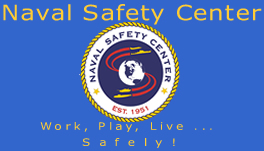 |
 |
|||||||||||||
|
||||||||||||||||||||||||||||||||||||||||||||||||||||||||||||
Managing Risk To Operate: Making ORM Part of Navy Culture While good service-wide initiatives come and go, ORM has been around for more than a decade. Why? Because its simple, common-sense approach is a uniquely useful tool for achieving excellence while preventing mishaps. So why is it that the highest-ranking leaders in the Navy continue to espouse the virtues of ORM, and yet the youngest of our Sailors and our junior leaders have trouble understanding the basic steps of the process? This special issue is a navigation aid to help us change course and make ORM an integral part of Navy and Marine Corps culture. It is a guide to changing our perceptions of what ORM is and what it is not. ORM is not about avoiding or eliminating all risk in what we do. We face risk every time we get into our cars, man an aircraft or take in lines from a pier. These risks don’t keep us from doing our jobs. When Admiral John Nathman coined the phrase “Managing Risk to Operate,” he made it clear that ORM is about getting the job done while keeping our people and equipment capable of doing it again tomorrow. This is why the ORM effort fleet-wide is being reinvigorated and standardized. Where We Want To Be We want everyone to understand risk management. We want them to know how to apply the principles and the process at the right level in their specific tasks and activities, on and off duty. We need every Sailor and Marine to understand that every death on the highway robs us of a vital part of our team every bit as much as a loss in combat. A critical step is changing people’s perceptions of ORM:
The Way Ahead Ingraining ORM into our culture will require leaders to think and plan with the principles and concepts of ORM fully integrated. Leaders must teach ORM techniques to our newest service members. Junior personnel must understand that they need to master a simple set of skills to effectively play their positions on the team, watch for changes, and communicate what they see to their teammates. All hands must know and use ORM terms so everyone knows the process is in action. Through this ORM issue, we give you a guide to understanding and applying ORM, and a road map to shaping Navy and Marine Corps culture—a culture where managing risk is key to operating… and winning. |
Privacy Advisory: We will not obtain personally identifying information about you when you visit our site unless you choose to provide such information to us. If you choose to send email to the site webmaster, any contact information that you provide will be solely used to respond to your request and not stored. |
||